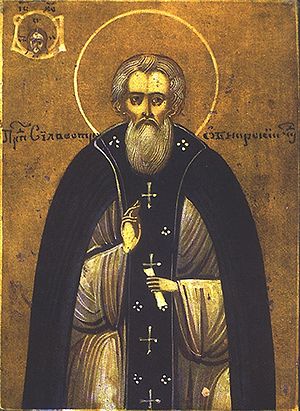Saint Sylvester of Obnora was a disciple and novice under Saint Sergius of Radonezh (September 25 and July 5). After completing his obedience at the Trinity monastery, Saint Sylvester received a blessing to live alone in the wilderness.
In the deep forest at the River Obnora, flowing into the River Kostroma, he set up a cross at his chosen spot and began his ascetical labors. For a long time no one knew about the holy hermit. His cell was discovered by a peasant who had lost his way. He told the distraught hermit that people had seen bright rays, and a pillar of cloud above his habitation. The monk shed tears of sorrow, because the place of his solitude had been discovered. The pilgrim besought the saint to tell about himself.
Saint Sylvester said that he had been living there a long time, and that he ate tree bark and roots. At first he became weak without bread, and fell on the ground from his weakness. Then an angel appeared to him in the guise of a wondrous man and touched his hand. From that moment Saint Sylvester did not experience any distress. Another time, the peasant came back to the saint and brought him bread and flour for reserve supply.
This one meeting was sufficient for the exploits of the hermit to become known to many. Soon peasants began to come to him from the surrounding settlements. Saint Sylvester allowed them to build cells near his.
When the brethren had gathered, Saint Sylvester went to Moscow and petitioned Saint Alexis (February 12) to bless the construction of a temple in honor of the Resurrection of Christ. The hierarch gave him an antimension (a cloth containing relics of martyrs, necessary for celebrating the Divine Liturgy), and made him igumen of the monastery.
With the construction of the church the number of brethren quickly grew, and the saint frequently withdrew for solitary prayer in the dense forest. This spot received the name “Commanded Grove,” since Saint Sylvester commanded that no trees should be cut there. In this grove he dug three wells, and a fourth on the side of a hill at the River Obnora. When the saint returned from his solitude, a number of people awaited him at the monastery, and each wanted to receive his blessing and hear his advice.
The saint fell into a fatal illness, and the brethren, who were distressed whenever he went into seclusion, were even more distressed about his approaching death. “Do not grieve about this, my beloved brethren,” he said to console them, “for everything is according to the will of God. Keep the commandments of the Lord and don’t be afraid to suffer misfortune in this life, so you may receive a reward in Heaven. If I have found boldness before the Lord and my life is pleasing to Him, then this holy place will not diminish after my departure. Pray to the Lord God and His All-Pure Mother, that you may be delivered from temptation.” Saint Sylvester died on April 25, 1479 and was buried on the right side of the wooden Resurrection church.
A record of the saint’s miracles has been preserved from the year 1645, in which twenty-three miracles are described. The saint healed twelve people from demonic possession and delirium, and six others from eye afflictions.
An edifying miracle occurred in 1645. The hieromonk Job of the monastery ordered peasants to cut down the forbidden forest grove for firewood, and he was struck blind. After four weeks he acknowledged his sin, repented and vowed not to act on his own will, but to follow the advice of the brethren. The hieromonk served a Molieben in church, after which he was brought to the reliquary of Saint Sylvester, and there he regained his sight.



